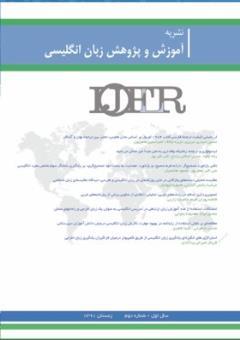Evaluating an Innovative Model for On-the-Job Training of Iranian EFL Teachers
Subject Areas :
Toktam Parhizkar Khadiv
1
![]() ,
Farhad Fahandezh
2
*
,
Farhad Fahandezh
2
*
![]() ,
Shahram Afraz
3
,
Shahram Afraz
3
![]()
1 - Department of English Language, Qeshm Branch, Islamic Azad University, Qeshm, Iran
2 - Department of English Language, Bandar Lenge Branch, Islamic Azad University, Bandar Lenge, Iran
3 - Department of English Language, Qeshm Branch, Islamic Azad University, Qeshm, Iran
Keywords: Job Training Course, in service training, Model, teachers training,
Abstract :
Abstract The main purpose of this study is to present and evaluate a model to execute successful On the Job Training Course for Iranian EFL teachers. In order to achieve the goal of the study, 441 teachers of different language institutes in several cities of Iran were asked to complete a self-made questionnaire which was designed based on some face-to-face interviews and observation documents of 26 teachers. As factor analysis was the most crucial concern of this study, the 43 items of the questionnaire were piloted on a sample of 147 EFL teachers. Regarding this matter, the scale in this study enjoyed having a sufficient communality value greater than 0.5 for 25 questions in the questionnaire out of 43 questions. Pearson’s correlation coefficient and structural equation modeling (SEM) were run to analyze the relationships among the components. The result revealed that the research model was in the domain of acceptance. The findings of this study can provide fruitful information for English teaching and learning stakeholders, educational policy makers, supervisors, and those involved in second language teacher education as well as English language teachers in EFL contexts.
Alibakhshi, G., & Dehvari, N. (2015). EFL teachers' perceptions of continuing professional development: A case of Iranian high school teachers. Profile Issues in Teachers Professional Development, 17(2), 29-42.
Aykac, N., Yildirim, K., Altinkurt, Y., & Marsh, M. M. (2017). Understanding the underlying factors affecting the perception of pre-service teachers’ teacher identity: A new instrument to support teacher education. Üniversitepark Bülten, 6(1), 67.
Balbay, S., Pamuk, I., Temir, T., & Doğan, C. (2018). Issues in pre-service and in-service teacher-training programs for university English instructors in Turkey. Journal of Language and Linguistic Studies, 14(2), 48-60.
Bentler, P. M. (1990). Comparative fit indexes in structuralmodels. Psychological Bulletin, 107, 238-246.
Berry, B., Hoke, M., & Hirsch, E. (2004). The search for highly qualified teachers. Phi Delta Kappan, 85(9), 684-689.
Besharati, M., & Mazdayasna, G. (2017). Investigating the effect of team-teaching approach on ESP students’ English proficiency; evidence from students’ attitudes. International Journal of Applied Linguistics and English Literature, 6(5), 41-50.
Bolitho, R. (2016). The ingredients of quality in teacher education. Ensuring Quality in English Language Teacher Education, 26, 26-32.
Brown, T. A., & Moore, M. T. (2012). Confirmatory factor analysis. Handbook of structural equation modeling, 361, 379.
Cheung, H. Y. (2006). The measurement of teacher efficacy: Hong Kong primary in‐service teachers. Journal of Education for Teaching, 32(4), 435-451.
Desimone, L. M. (2009). Improving impact studies of teachers’ professional development: Toward better conceptualizations and measures. Educational Researcher, 38(3), 181-199.
Diaz-Maggioli, G. (2004). Teacher-centered professional development. ASCD.
Ganji, M., Ketabi, S., & Shahnazari, M. (2018). English teacher training courses in Iranian private language institutes: Issues and options. Issues in Educational Research, 28(2), 367-384.
Göksel, Ş., & SÖYLEMEZ, A. R. (2018). Becoming a professional: Exploring EFL pre-service teachers’ conceptions of an effective foreign language teacher. Journal of Language and Linguistic Studies, 14(4), 111-135.
Harmer, J. (2008). How to teach English (Vol. 62, No. 3, pp. 313-316). Oxford University Press.
Heathfield, S. M. (2018). How on-the-job training brings you value: Using managers and coworkers to effectively train employees on the job.
Hemaid, R. K., & El-Halees, A. M. (2015). Improving teacher performance using data mining. International Journal of Advanced Research in Computer and Communication Engineering, 4(2), 407-412.
Hismanoglu, M. (2019). A Study on the Qualities of Effective EFL Teachers from the Perspectives of Preparatory Program Turkish EFL Students. International Journal of Curriculum and Instruction, 11(1), 101-124.
Kenny, D. A., Kaniskan, B., & McCoach, D. B. (2015). The performance of RMSEA in models with small degrees of freedom. Sociological methods & research, 44(3), 486-507.
Khaksefidi, S. (2015). Foreign language teaching in Iran: A model for effective EFL teaching in the Iranian context. Theory and Practice in Language Studies, 5(5), 1060.
Koç, E. M. (2016). A General Investigation of the In-Service Training of English Language Teachers at Elementary Schools in Turkey. International Electronic Journal of Elementary Education, 8(3), 455-466.
Koellner, K., & Greenblatt, D. (2018). Inservice teacher education. Oxford bibliographies.
Miles, K. H., Odden, A., Fermanich, M., & Archibald, S. (2004). Inside the black box of school district spending on professional development: Lessons from five urban districts. Journal of Education Finance, 30(1), 1-26.
Mohammadi, M., & Moradi, K. (2017). Exploring change in EFL teachers’ perceptions of professional development. Journal of Teacher Education for Sustainability, 19(1), 22-42.
Nicolaidis, K., & Mattheoudakis, M. (2008). Utopia vs. reality: the effectiveness of in‐service training courses for EFL teachers. European Journal of Teacher Education, 31(3), 279-292.
Novozhenina, A., & López Pinzón, M. M. (2018). Impact of a professional development program on EFL teachers’ performance. How, 25(2), 113-128.
Öztürk, M. (2019). An Evaluation of an Innovative In-Service Teacher Training Model in Turkey. International Journal of Higher Education, 8(1), 23-36.
Wang, S. D., Scrivener, K. L., & Pratt, P. L. (1994). Factors affecting the strength of alkali-activated slag. Cement and concrete research, 24(6), 1033-1043.
Ulla, M. B. (2017). Teacher Training in Myanmar: Teachers' Perceptions and Implications. International Journal of Instruction, 10(2), 103-118.

